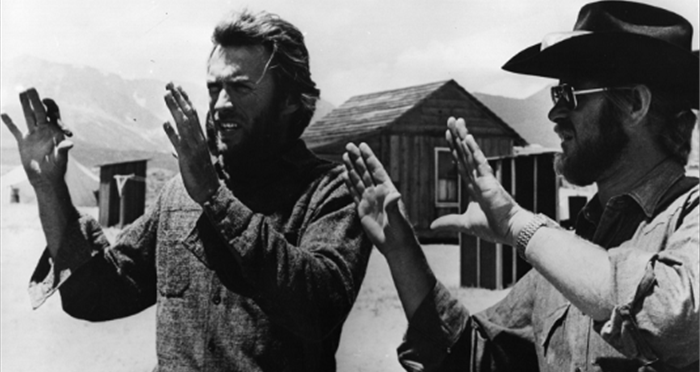High Plains Drifter (1973) is the first Western that Clint Eastwood directed. It’s a little different from the rest of the westerns he made, as an actor or as a director, as it plays out more as a supernatural thriller.
“That isn’t what the West was all about. That isn’t the American people who settled this country.” – John Wayne on High Plains Drifter
It might appear a little ominous to start talking about a western with a quote bashing the movie and that too from legendary western Icon John Wayne. But we are discussing a rather strange movie that polarizes the audiences, and Wayne’s reaction is a pointer towards that. To put Wayne’s quote in context : John ‘Duke’ Wayne and Clint Eastwood have a lot in common. They are ‘the‘ two biggest movie stars of all time.
Both extremely prolific and long lasting. Both became icons through their perfect embodiment of the Archetypal American male in the most popular American film genre of the ‘Western‘ . They are both blessed with ruggedly handsome looks and a towering personality that makes them perfect for these films that unfold against the grand vistas of American frontier wilderness. Both of them had a couple of great directors helping them in shaping their iconography at various stages of their career. For Wayne, it was John Ford and Howard Hawks ; For Clint, it was Sergio Leone and Don Siegel. Above all, both are politically conservative. So, with so much in common, one would obviously assume that Duke had a great deal of admiration for Clint, who could be considered his heir apparent.

Not so i am afraid, professionally at least as it is obvious from Wayne’s feelings about Clint’s 1973 film High Plains Drifter quoted above. The main reason for this was: American west that was presented in Duke’s films was very different from the ones that we got to see in Clint’s films. Duke came of age as a star in the triumphant years of 1940’s and 50’s . His films were concerned with the glories of the white man who settled the west. They are portrayed as pioneers who brought modernity and prosperity to the resplendent landscape that was under the savagery of the Native American tribes. On the other hand, Clint attained stardom in the counter-cultural, swinging 60’s which was a period of revisionism . His Westerns were more about the schism, the violence and the savagery that existed within the, so called , modern society that replaced the primitive tribal society. Duke, like the characters he portrayed, wholeheartedly believed in the nobility and the adventurous spirit of the white settlers who went west and brought with them the benefits of modern civilization and established modern towns and cities. But, by the time Clint came long , the concept of the ‘savage injun as the bad guy‘ was passé.
Even great western auteurs like John Ford were making their own ‘mea culpas’ like Cheyenne Autumn during this period. In Clint’s films, the settlers are portrayed as mean, morally corrupt, violent and no more civilized than the natives. So it’s natural for Duke to have a certain extend of disdain for Clint’s movies. Also, Duke’s characters (with some exceptions) never lost their moral center. They operated within the strict parameters of what is universally perceived as right and wrong. He never shot anybody in the back. He was also adamant that when he shot someone, the action has to be cut in such a way that we never see the gun being fired and the recipient of the bullet being killed in a single shot. Clint, on the other hand, would go on to break every one of these rules. Sergio Leone’s A Fistful of Dollars, the film that made Clint a star, would be the first film where we saw the gun being fired and people being shot down in the very same frame. And Clint had no scruples about shooting people in the back either.

His characters are only concerned with their own survival . There’s an interesting story that happened on the set of Duke’s last film The Shootist , which was directed by Clint Favorite Don Siegel. Siegel suggested that Duke shoot the villain in the back. When Duke balked at the suggestion, Siegel, rather un-diplomatically, let go that Clint would have shot the guy in the back . This comment enraged Duke and he fired back: “John Wayne never shoots anybody in the back, he is not like that new kid Clint Eastwood“. It was Clint’s big dream to do a film with Duke and he sent a letter to Duke expressing his desire to work with him. But Duke turned it down, responding with an angry letter, in which he denounced his films, particularly High Plains Drifter, for its violence and revisionist portrayal of the Old West. Eastwood did not bother to answer his criticisms, and consequently, the dream team-up never happened.
John Wayne’s criticism notwithstanding, High Plains Drifter is one of the most stylized, moody, bizarre and out of the box westerns ever made. Clint Eastwood’s first western as a director – He had already made his directorial debut with 1971 romantic thriller Play Misty for me – takes his ‘Man with no name’ Character, that he originated in Sergio Leone’s spaghetti westerns, to it’s logical extreme; which is to make it less a character and more an abstract supernatural force .

Leave a Reply